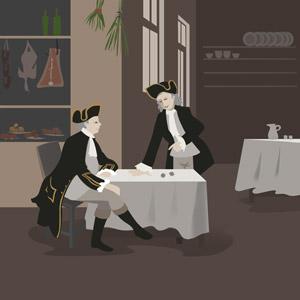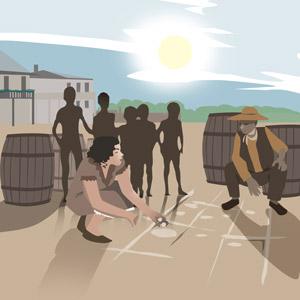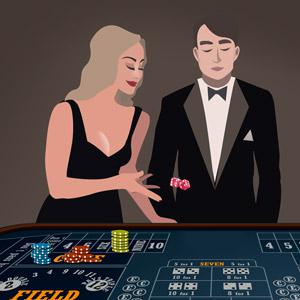Have you ever wondered where craps got its name? Well, it’s a colorful story as lively, exciting and fun as the game itself.
It is said the origins of the game date back to 1125 and the crusades. For the most part, the crusades were a pretty messy affair filled with equal measures of bloodshed, terror and tedium, the perfect setting for what would become the world’s most glamorous casino game. They say it all started with a letter.
Why’s it called craps?
In 1094 the Byzantine Emperor, Alexis I was in a bit of a tizzy. It seems the Seljuq Turks were on a rampage, and had taken huge parts of Asia Minor from him and were threatening to invade Constantinople (modern Istanbul). He decided to call for help. He wrote a letter to Pope Urban II to ask if he could send an army to his aid and rid himself of those rather pesky Seljuq Turks. The Pope agreed and, keen to consolidate his power in Europe, issued a call for all Christians in Europe to head out on a Crusade to reclaim the Holy Land.
 As this was the Middle Ages and there wasn’t a whole lot going on, a great army of ne’er-do-wells, peasants, zealots, and aspiring heroes amounting to some 60,000 to 100,000 souls, set out in no time in search of glory. From all accounts it was a rather long, miserable march, and a terribly bloody affair as they fought their way toward Jerusalem. The first Crusaders succeeded in their mission and captured Jerusalem in far less time than they expected and there wasn’t much left to do. After the tedium of the journey, thrill of battle and boredom that followed there was nothing left to pillage, so many decided it was time to go home. So what’s this got to do with craps you ask? Well, everything.
As this was the Middle Ages and there wasn’t a whole lot going on, a great army of ne’er-do-wells, peasants, zealots, and aspiring heroes amounting to some 60,000 to 100,000 souls, set out in no time in search of glory. From all accounts it was a rather long, miserable march, and a terribly bloody affair as they fought their way toward Jerusalem. The first Crusaders succeeded in their mission and captured Jerusalem in far less time than they expected and there wasn’t much left to do. After the tedium of the journey, thrill of battle and boredom that followed there was nothing left to pillage, so many decided it was time to go home. So what’s this got to do with craps you ask? Well, everything.
They left behind a horde of brave and ambitious men (or so they say), who founded four Crusader states, guarded by large castles to protect the Holy Land. One of these states was the Kingdom of Jerusalem. A man named Sir William of Tyre grew up there and is said to have been the creator of what we know today as the game of craps.
 The nature of medieval warfare, the boredom of provincial life in a far-off land and the need for some thrills now and again probably had a lot to do with it. In time William became an archbishop and regularly accompanied groups of knights as they headed out to siege distant castles to protect the Kingdom of Jerusalem from Seljuk Turks. These campaigns were long, boring and monotonous, filled with dust, flies, few creature comforts and not a whole lot to do between assaults. To help his flock pass the time (one can imagine them rolling their eyes at yet another sermon), William invented a dice game. It was called Hazard, after the English pronunciation of the castle to which they were laying siege at the time.
The nature of medieval warfare, the boredom of provincial life in a far-off land and the need for some thrills now and again probably had a lot to do with it. In time William became an archbishop and regularly accompanied groups of knights as they headed out to siege distant castles to protect the Kingdom of Jerusalem from Seljuk Turks. These campaigns were long, boring and monotonous, filled with dust, flies, few creature comforts and not a whole lot to do between assaults. To help his flock pass the time (one can imagine them rolling their eyes at yet another sermon), William invented a dice game. It was called Hazard, after the English pronunciation of the castle to which they were laying siege at the time.
From there, learned by Crusaders returning home after their tours protecting the Holy Land, the game made its way back to England, where it seems to have become rather popular. It is first mentioned in writing with the publication of Geoffrey Chaucer’s The Canterbury Tales in 1478. By the 17th century it was a common feature of English tavern life and had spread to parlors and salons across Europe with slight variations in the rules.
It took some time, but the game eventually made its way to the Americas. Exactly how remains a matter of some contention, with arguments being made that it was brought over on the Mayflower by the English or brought to America by French settlers who were disposed of their colony in Nova Scotia in today’s Canada.
 Perhaps the most popular of stories says that craps actually landed in America via New Orleans thanks to a Frenchman named Bernard de Marigny. A French Creole American Nobleman descended from colonial landowners, he had visited England as a young man. A military officer, known to be a bit of a playboy and tavern lover, he adored games of chance. It is said that he fell in love with Hazard and modified the English version to suit his tastes. But, it seems there was a bit of a flaw in his rules, by which players could exploit the casino using fixed dice and taking advantage of the way players can bet with or against the dice thrower.
Perhaps the most popular of stories says that craps actually landed in America via New Orleans thanks to a Frenchman named Bernard de Marigny. A French Creole American Nobleman descended from colonial landowners, he had visited England as a young man. A military officer, known to be a bit of a playboy and tavern lover, he adored games of chance. It is said that he fell in love with Hazard and modified the English version to suit his tastes. But, it seems there was a bit of a flaw in his rules, by which players could exploit the casino using fixed dice and taking advantage of the way players can bet with or against the dice thrower.
To solve the problem, an American dice maker named John H. Winn introduced the “don’t pass” betting option that we have in craps today and became known as the modern father of craps.
 In New Orleans, at the time of Bernard de Marigny, the game was known as ‘crapaud’, derived from the French word for ‘toad’. Thanks to its low origins as a soldiers’ game, in its early days craps was played on the floor, in the dust up against a stone wall, no fancy table necessary. All you needed was a pair of dice and a bit of cash. This meant people had to squat down in order to play – a position that gave them a distinctly toad-like appearance.
In New Orleans, at the time of Bernard de Marigny, the game was known as ‘crapaud’, derived from the French word for ‘toad’. Thanks to its low origins as a soldiers’ game, in its early days craps was played on the floor, in the dust up against a stone wall, no fancy table necessary. All you needed was a pair of dice and a bit of cash. This meant people had to squat down in order to play – a position that gave them a distinctly toad-like appearance.
There is, however an alternative version of the origins of the word, which says that craps comes from the French word “crabes”, meaning crabs, a reference to the lowest value of a throw of the dice or what we call “snake eyes” today, two ones.
However it got its modern name, by the time World War II came along, craps was a popular street game. It was eagerly adopted by soldiers with long boring periods of time to kill before or in-between deployments and who would use a GI blanket as a surface on which to roll. So it seems craps had made it full circle and returned to its roots as a way for soldiers to kill time and get a kick amid the tedium and discomfort of war.
But that would not be the end of the story. As with so many things that start with the nitty gritty of roughing it (whether on the street or camping in far off lands) craps became increasingly popular with the well-to-do. Simply put, it was hip and cool because the everyman loved it, so they had to also.
It’s difficult to say when craps actually entered the casino proper, or when craps online became a thing, but when it did, it did with a flare. Popular depictions of craps in film are laden with sex and glamour. From Sean Connery as James Bond in?Diamonds Are Forever?rolling the dice while rubbing up against Plenty O’Toole played by the voluptuous Lana Wood in 1971, to Demi Moore as Diana Murphy in?Indecent Proposal, kissing the dice as billionaire John Gage (Robert Redford) smiles at her lustfully, to Sharon Stone as Ginger, the high-end prostitute and hustler in?Casino, making a scene at the craps table to get casino owner Sam “Ace” Rothstein’s (played by Robert De Nero) attention, craps is associated with lust, love and luxury.
But one way or another craps is never far from its roots as a pastime for the down and out, looking for thrills and escape from the boredom and hardship of life.
Perhaps the ultimate depiction of craps’s colorful origins can be found in the opening scene of HBO’s 2002 series The Wire. As the sound of Tom Waits’ song Way Down in the Hole fades, Detective Jimmy McNulty (played by Dominic West) sits on a street corner awash in police siren lights in the Baltimore night. A young man named Snot Boogey has been killed and detective McNulty is trying to understand why. Seems the dead youth had a habit of hanging around the craps games in the alleys, waiting until the pot was big enough and running off with all the money. McNulty asks the young man next to him something along the lines of, “Let me get this straight, if he ran off with the money every time, why did you let him back in the game?” And the answer from the young man in the hoodie next to him on the street: “Gots to man, this is America.”
So there we have a brief lowdown into how craps first came about. If you’re ready to put your online craps skills to the test and play craps online for real money, you can do just that with Planet 7 online casino! And if you’re new to the world of craps, check out our handy beginner’s guide to?craps for some helpful tips and tricks!






